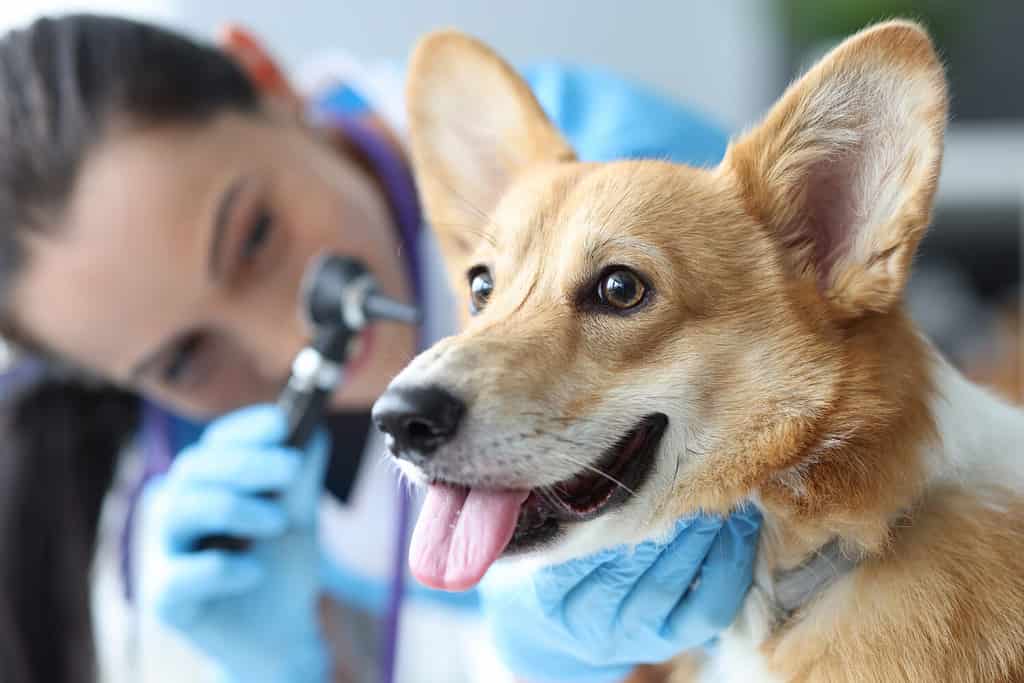Has your little one just been prescribed a medication called cephalexin? We know you likely have questions on how this medication will impact your pup, so we’re here to tell you all there is to know about cephalexin use in dogs.
In this article we will discuss the details of cephalexin, safe dosing, common side effects, and more!
Let’s get started.
What Is Cephalexin?

Cephalexin is an antibiotic used to treat simple bacterial infections in dogs.
©Donna Ellen Coleman/Shutterstock.com
Cephalexin is an antibiotic that is commonly used in both human and animal medicine. It is also found under the name Keflex, and it can only be obtained with a prescription from a doctor or veterinarian.
Cephalexin belongs to the cephalosporin class of antibiotics. It works by disrupting the growth process of the bacteria cell wall, helping to stop the current infection in its tracks. Cephalexin can tackle an array of simple infections, but it cannot be used to treat viral infections.
Is Cephalexin Safe For Dogs?
Cephalexin is safe for use in dogs when following your veterinarian’s guidance. It is one of the most commonly prescribed antibiotics in dogs for a variety of reasons, ranging from its minimal side effects to low incidence of overdose. Cephalexin in a trusted tool when fighting simple canine infections.
Why Do Dogs Take Cephalexin?
Cephalexin is used to treat simple bacterial infections in dogs, but let’s break down some of the most common conditions it is prescribed with.
Skin infections: Cephalexin is most commonly used to treat a skin infection in dogs called pyoderma. Pyoderma is a bacterial skin infection that leads to pustules on the surface of the dog’s skin, and these pustules can often become infected and painful. Other signs of pyoderma include skin crusting, hair loss, and skin odor. Cephalexin typically clears this bacterial infection with ease, but some pups will also be prescribed medicated shampoos or topical sprays to speed up healing.
Ear infections: Cephalexin can be used to treat ear infections in dogs. It can be used on its own in simple ear infections, but it may be prescribed alongside other medications with more complicated ear infections.
Respiratory infections: Cephalexin can be used to treat simple respiratory infections in dogs, and it may be prescribed alongside other medications to treat pneumonia. However, it will only be effective in fighting bacterial respiratory infections, so if the infection is viral in nature, it will not resolve the issue.
Simple urinary infections: Cephalexin is often used to treat urinary tract infections in dogs. If your pup is experiencing a significant amount of pain, it may be prescribed alongside anti-inflammatory or pain control medications.
How Is Cephalexin Given In Dogs?
Cephalexin is most commonly prescribed in pill form, but it can be compounded into a liquid when necessary. It should be given by mouth as instructed by your veterinarian, and it should always be given with a meal. Cephalexin can lead to nausea and vomiting when given on an empty stomach, so we highly suggest offering it to your pup with breakfast and dinner.
What Is The Dose Of Cephalexin In Dogs?
Before we discuss the standard dose of cephalexin for dogs, we should mention again that you should never give your dog cephalexin without veterinary approval. Your vet can prescribe an appropriate dose based on your dog’s size and the medical condition being treated. With that being said, most veterinarians will follow a standard dosing range.
The standard dose for cephalexin in dogs is 10 to 15 mg per pound of body weight, every 12 to 24 hours based on your vet’s guidance. Let’s offer some examples!
Cephalexin pills will often be found in 250 and 500 mg capsules, but liquid form can be found in a 50mg/ml concentration. Your vet will often round your dog’s dose to best fit the concentration of the form of cephalexin that is prescribed.
| 10 pounds | 100-150 mg |
| 20 pounds | 200-300 mg |
| 30 pounds | 300-450 mg |
| 40 pounds | 400-600 mg |
| 50 pounds | 500-750 mg |
| 60 pounds | 600-900 mg |
| 70 pounds | 700-1000 mg |
| 80 pounds | 800-1200 mg |
| 90 pounds | 900-1350 mg |
Are There Side Effects With Cephalexin Use In Dogs?

Cephalexin can be used to treat skin, ear, respiratory, and urinary infections in dogs.
©megaflopp/Shutterstock.com
Side effects with cephalexin use in dogs are rare, but they can occur in some furry friends. Let’s list a few possibly side effects of cephalexin in dogs to be on the lookout for.
- Nausea
- Vomiting
- Diarrhea
- Flatulence
- Skin irritation
The above side effects are most common in dogs that do not take cephalexin with a meal. Always offer antibiotics with a meal to decrease the likelihood of experiencing GI upset.
However, skin irritation is not related to how the medication is given, so always reach out to your vet if your dog develops a skin rash.
Risks Of Cephalexin Use In Dogs
There are few risks associated with cephalexin use in dogs, but it should be used cautiously in pets with kidney or liver disease. You should also let your vet know if your dog is pregnant or nursing, as cephalexin can potentially cross into the placenta. Whether or not it enter the mother’s milk is unclear, but your vet may choose a different antibiotic option instead to be safe.
How Do I Get Cephalexin For My Dog?
Cephalexin is not an over the counter medication, and it can only be obtained with a prescription from your veterinarian. We suggest having your pet assessed by your veterinary team if you think they can benefit from the use of cephalexin!
The photo featured at the top of this post is © iStock.com/Yana Tikhonova
Ready to discover the top 10 cutest dog breeds in the entire world?
How about the fastest dogs, the largest dogs and those that are -- quite frankly -- just the kindest dogs on the planet? Each day, AZ Animals sends out lists just like this to our thousands of email subscribers. And the best part? It's FREE. Join today by entering your email below.
Thank you for reading! Have some feedback for us? Contact the AZ Animals editorial team.






